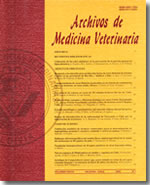Distribution and viability of cyticerci of Taenia saginata in meat cuts from naturally infected beef
Main Article Content
Abstract
The anatomical distribution and viability of cysticerci of Taenia saginata in naturally infected cattle slaughtered in southern Chile was determined. The cattle were inspected post mortem according to official chilean procedures, where mandatory inspection sites are: heart, tongue, masseter, oesophagus, diaphragm and superficial observation of the carcass. Twenty carcasses diagnosed as positive during inspection were chosen at random and their left half sides were separated into the 33 official meat cuts; these were completely dissected into approximately 0.5 cm thick slices and number of cysts determined by visual inspection. Lesions compatible with cysticerci of Taenia saginata were diagnosed according to official procedures in 148 cattle (0.5% prevalence) at mandatory sites, finding that 64.9% of them were located in heart, 33.8% in masseter muscles, 0.7% in oesophagus and 0.7% in the carcasses. At histological examination, 82.9% of the lesions were diagnosed as nonviable cysts and only 5.1% were viable; 10.7% corresponded to other diagnoses (mostly myositis and myocarditis, followed by schwannoma in heart and actynomycosis in tongue) and in 1.3% no alteration could be found. Fourteen cysts were found in the meat cuts of the 20 positive to cysticerci of Taenia saginata in carcasses, all were nonviable; cysts were found in tenderloin, point end brisket, rump heart, silverside, cube roll cover, ribs, topside, flanck meat, bolar and thin skirt. It is concluded that chances of finding cysticerci in meat cuts of cattle diagnosed positive to cysticerci of Taenia saginata at slaughter inspection is limited, especially when animals are infected in a mild form, as it happens in Chile.

